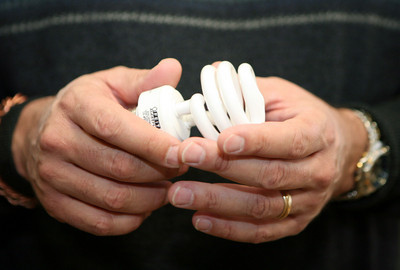Seasonal Savings
As the Christmas bills start arriving and the temperature drops, saving on power bills in the summer probably is the last thing on the mind of typical consumers. But how about no-cost improvements that will cut bills now?
NV Energy, the utility that formerly did business as Nevada Power Co., offers a list of no-cost things to do to reduce electric bills by 10 percent to 25 percent over the year.
During winter, set the thermostat to 68 degrees when you're home and lower it to 58 degrees when you leave or sleep.
"Nothing is going to freeze at these temperatures," said Greg Kern, NV Energy director of customer renewable generation and energy efficiency.
During warm months, NV Energy recommends setting the thermostat to 78 or 80 degrees. Let it drift up to 85 degrees while you are away from home, Kern said. NV Energy gives residential customers a free programmable thermostat that can be controlled through the Internet when they sign up for Cool Share.
This program allows the utility company to reduce air conditioner use during the hottest hours of weekdays when temperatures soar to 104 degrees and higher.
The air conditioning adjustment may allow the temperature to climb by 4 degrees, but residential customers can earn up to $29 yearly for each central air conditioning unit.
NV Energy seeks to cut power consumption during peak periods because that's when power costs the most.
By reducing power use during peak periods, "you delay the building of power plants," Kern said. "It's kind of a 'green' thing to do."
Officials suggest other energy-saving tips:
* During winter months, open the blinds or drapes on windows on the sunny side of the house to get heat from the sun. Close them at night.
* Set the water heater to 120 degrees to save energy, the utility suggested.
* Vacuum refrigerator coils underneath and behind the unit to improve energy efficiency.
* Get rid of the old refrigerator in the garage. NV Energy will pay a consumer $30 and pick up the old unit. Older refrigerators cost $50 to $75 a month to run, Kern said. A 10-year-old refrigerator uses twice as much electricity as a new one.
* Run full loads in clothes washers and dryers to save money. Better still, use the sun to dry clothes.
* Use the energy saver option on dishwashers and let the air dry the dishes.
* Turn off lights and appliances when they are not being used.
Unplug televisions when on vacation, because they often create a "vampire load" and pull electricity even when turned off, Kern said.
(When buying big screen TVs, Kern recommends energy-efficient liquid-crystal display or LCD units, rather than plasma screens.)
The next step: Low-cost measures for saving power.
* Change air conditioner and heating system filters at least every two months.
"If you can pinch some stuff on it, it's time to change it out," he said.
The question of whether to use cheap or expensive filters depends on the air quality desired, he said.
"Lighting typically accounts for 10 percent of home power bills. Compact fluorescent will cut 75 percent of 10 percent," Kern said.
* Caulk around windows and install weather strips around doors. Not only is a tighter house more energy efficient, it's more comfortable because it's not drafty, Kern said.
"Weatherizing and tightening up your house is always a good thing to do as the seasons are changing," he said.
Spring and fall also are good times to get new air conditioners.
"If it's too cold, the technician can't install it correctly," Kern said. "I would always start out with cooling in the summer because that's where the juice goes."
He estimated that air conditioners account for half or more of the typical power consumption yearly at most residences that don't have swimming pools.
Before spending big bucks on a new air conditioner, consider other things that cost much less. Use shade trees to cool the southwest walls and windows.
Ceiling fans cut body temperature by 4 to 6 degrees. Switch the fan to blow down in the summer and to pull air up in the winter, he said.
Consider a tune-up for the air conditioner.
"An air conditioner is like a car," Kern said. "It needs to be tuned up every five or seven years."
As a rule of thumb, a 15-year-old air conditioner is half as efficient as a new one, he said.
Swimming pools are power hogs and can account for 15 percent to 20 percent of annual power consumption, but homeowners can take steps to reduce the power pools use.
First, reduce the time the pool pump runs daily, Kern said.
Start at 13 hours when the water is crystal clear. Cut down the daily pumping time by an hour daily until it's no longer clear. Then, raise it to the minimum needed for clarity.
For even more power savings, install a variable speed pump.
That will reduce pool power consumption by 25 percent to 50 percent, he said.
Contact reporter John G. Edwards at jedwards@reviewjournal.com or 702-383-0420.


















